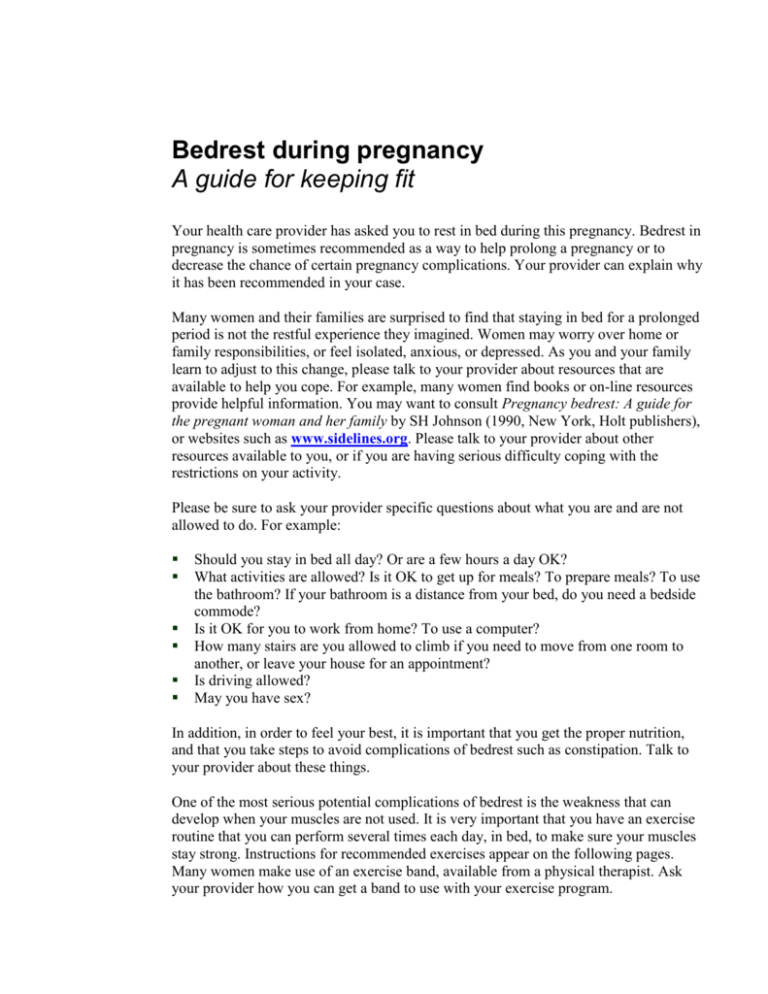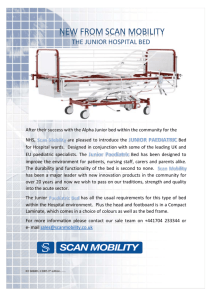
Bedrest during pregnancy
A guide for keeping fit
Your health care provider has asked you to rest in bed during this pregnancy. Bedrest in
pregnancy is sometimes recommended as a way to help prolong a pregnancy or to
decrease the chance of certain pregnancy complications. Your provider can explain why
it has been recommended in your case.
Many women and their families are surprised to find that staying in bed for a prolonged
period is not the restful experience they imagined. Women may worry over home or
family responsibilities, or feel isolated, anxious, or depressed. As you and your family
learn to adjust to this change, please talk to your provider about resources that are
available to help you cope. For example, many women find books or on-line resources
provide helpful information. You may want to consult Pregnancy bedrest: A guide for
the pregnant woman and her family by SH Johnson (1990, New York, Holt publishers),
or websites such as www.sidelines.org. Please talk to your provider about other
resources available to you, or if you are having serious difficulty coping with the
restrictions on your activity.
Please be sure to ask your provider specific questions about what you are and are not
allowed to do. For example:
Should you stay in bed all day? Or are a few hours a day OK?
What activities are allowed? Is it OK to get up for meals? To prepare meals? To use
the bathroom? If your bathroom is a distance from your bed, do you need a bedside
commode?
Is it OK for you to work from home? To use a computer?
How many stairs are you allowed to climb if you need to move from one room to
another, or leave your house for an appointment?
Is driving allowed?
May you have sex?
In addition, in order to feel your best, it is important that you get the proper nutrition,
and that you take steps to avoid complications of bedrest such as constipation. Talk to
your provider about these things.
One of the most serious potential complications of bedrest is the weakness that can
develop when your muscles are not used. It is very important that you have an exercise
routine that you can perform several times each day, in bed, to make sure your muscles
stay strong. Instructions for recommended exercises appear on the following pages.
Many women make use of an exercise band, available from a physical therapist. Ask
your provider how you can get a band to use with your exercise program.
Exercises for pregnant women on bedrest
If you have any pain or discomfort when you do these exercises, stop right away and tell your
provider. All movement should be slow and controlled. For increased resistance, make the band
shorter.
Do 2-3 sets of 10-15 repetitions, 2-3 times a day.
Do the following while lying on your side.
Ankle pumps
With band around upper foot, point your toes away from
your body, hold for 5 seconds, and return to start position.
Side leg lifts
Slowly raise leg up and then return.
Kick backs (*Do not do this exercise if you have
placenta previa. Ask your doctor if you aren’t sure.)
Push upper leg back, hold 5 seconds, and return.
Leg push
Hold band steady while pushing down with leg until knee is
straight, then slowly return.
Elbow reach
Hold band steady with lower hand while slowly straightening the upper
arm’s elbow.
Elbow curls
Hold band steady with lower hand and slowly bend upper elbow.
Shoulder pull backs
Hold band steady with lower arm and bring upper arm back, keeping
elbow bent.
Arm raises
Holding band steady with lower arm, raise upper arm
straight over head.
Do the following while seated
Shoulder rolls
Sit with upright posture. Roll shoulders slowly in backwards direction.
Chin tucks
Slowly bring head backwards and tuck chin to chest.
Positioning while in bed
Proper positioning is very important while you are in bed. Lying on your side, especially your
left side, is the best position for you and your baby. However it is good to change your position
frequently (about every two hours).
Lying on your side: Place a pillow between your knees, and also a small pillow or folded
towel under your abdomen. You can also place a pillow behind your back and roll onto it so
that you are lying partially on your back.
Lying on your back: Lying on your back during pregnancy can result in low blood
pressure, which is not good for you or your baby. You can help with this by placing a small
pillow or folded towel under your right hip/buttock to shift the weight of the baby off your
blood vessels. If you ever feel unusually hot while lying on your back, or if you feel
dizziness, faintness, or hear ringing in your ears, move onto your side. If the feeling does
not pass, call for help.
Over
Getting in and out of bed
To get out of bed: Bend your knees (one at a time)
and roll onto your side near the edge of the bed,
keeping your shoulders and hips in line with each
other. Lower your legs off the bed while pushing
yourself upright with your arms.
To get back into bed: Start by sitting on the edge of
the bed. Lower yourself onto your side while raising
your legs at the same time. Keeping your shoulders
and hips in line and your knees bent, roll back onto
the bed.
This material was developed by clinicians from the departments of rehabilitation services and obstetrics and gynecology at Beth
Israel Deaconess Medical Center. It is produced and distributed by The Beth Israel Deaconess Learning Center. ©2004, Beth Israel
Deaconess Medical Center. All Rights Reserved.
MC0932, 2/04







